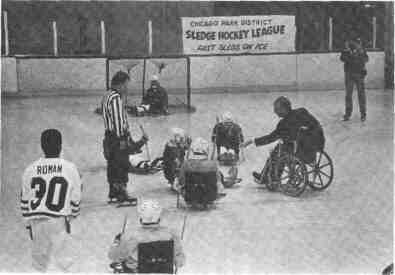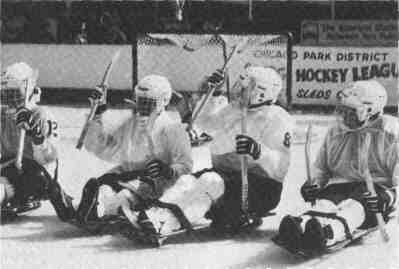 |
Home | Search | Browse | About IPO | Staff | Links |
 |
Home | Search | Browse | About IPO | Staff | Links |
|
Illinois Parks & Recreation May/June 1994 • Volume 25, Number 3
Cold Steel On Ice
The wing cuts away from a defender, fields a crossing pass, and fires a slap shot past the outstretched glove of the goalie for a score. Cold steel on ice, power plays, a crashing check into the boards, break away goals. If this brings up visions of a good old fashioned hockey game, it is ... but with a twist. The players are all seated on ice hockey sledges. The description above could just as easily describe the National Hockey League's Stanley Cup Finals as the World Cup Sledge Hockey Tournament. Sledge hockey has emerged from relative obscurity to being recognized as an International and Paralympic sport for persons with mobility impairments.

Sledge hockey has emerged from relative obscurity Established in Scandinavia several decades ago, hockey enthusiasts adapted crude, heavy snow sleds to play the first ice hockey game from a seated position. "Sledge" is the Scandinavian word for sled. Today, however, sledges are now constructed of lightweight materials, usually stainless steel or aluminum, and mounted on regulation ice hockey skate blades. The average weight of today's sledge is 12-18 pounds. New designs weighing less than 10 pounds, utilizing composite materials, are also being tested and developed in the same manner hockey skates continue to improve in weight performance. Sledge hockey allows persons with disabilities that prevent them from participating in regular standing ice hockey to enjoy and benefit from a vigorous, physical team sport that some describe as a cross between ice skating, rugby, bumper cars and ballet. Each player must have a permanent disability that would preclude playing regular competitive ice hockey. To equalize team abilities and ensure equal participation by players with differing levels of disabilities, a classification system has determined three ability levels. In most competitions, team point total of players on the ice cannot exceed 14 points. Each level is assigned a point value as follows: 1 point = players with no functional sitting balance or having major impairment of upper and/ or lower limbs. 2 points = players with no functional sitting balance but with impairment of limbs or the trunk/ hips and/or serious sensory limitations. 3 points = players with good sitting balance and minimal functional disabilities or only slight impairment of limbs or sensory perception. In some programs, especially juniors, when there are not enough players with disabilities or to promote integrated programming, able-bodied participants are allowed to play under the 3 point classification. When playing sledge hockey, the athlete sits low to the ice, strapped to the sledge. The sledge 24 • Illinois Parks & Recreation • May/June 1994 is basically a tubular frame balanced on a pair of ice hockey blades. The blades are positioned under the seat cushion at the player's center of gravity. The sledge contacts the ice at three points: the two blades and a small runner "ski." At the front of the sledge, a bent portion of tubing forms the front runner. Effective individual balancing of the player makes minimal contact of the front runner except when the player is leaning forward. Sledge hockey frames, like sport wheelchairs, come with seat dimensions from standard 14 inches to 18 inches and also can be custom individualized. The frame is uniformly 18 inches wide with adjustable lengths from 3-4 feet. All sledges are built to be 3.5 inches off the ice. This standard ensures that during games, sledges will contact each other frame to frame and one sledge will not spear the body of an opponent. Sledges are checked and measured before a game to ensure safe participation. A seat cushion is mounted on the frame with a back rest of varying lengths to promote whatever upper body support the player requires. Two straps secure the sledge to the player. One is tightened around the sledge seat and the player's waist. The second is placed over and under the sledge frame at the ankles or the thighs in the case of amputee player. An optional chest strap can also be used for players who need greater upper body stability. It is critical to achieve a secure body-sledge attachment making the sledge an extension of the lower body and easily controlled by slight body movements. Basically, the player wants to be balanced on the blades with movements of the hips and lower trunk transferred directly to the blades of the sledge. Many players utilize individual adaptions to maximize their control and skating ability. Common ones include foam cutouts or buildups to augment stability and cambering, widening or customizing blade placement for one side weakness or uneven weight distribution, as in amputees. Propulsion of the sledges is achieved by utilization of two shortened hockey sticks or "picks." The sticks have a row of metal teeth, similar to the toe pick on figure skates, attached to the blunt or non-blade end. The player reaches forward, plants the metal teeth on the ice, pulls the sledge forward and pushes off from the contact point. Although this may sound difficult, with practice, rhythm and technique, speed and maneuverability can be accomplished by even players with minimal upper body strength. The most difficult push is the first one from a stationary position, so many players try to remain constantly moving, even at a slow speed, during the game. 
When playing sledge hockey, the athlete sits low to the ice, The sticks also double as an adapted hockey stick to pass and shoot the puck. On the opposite end from the metal teeth, the stick contains a shortened, cut down blade. This blade end is utilized to pass, block the puck, and, hopefully, score a goal. The sticks can be adapted to address grasp deficiencies by adding compression foam or adhesive materials around the shaft, velcro to the shaft and gloves, notching or cutting ridges in the stick, or taping rope around the sticks to eliminate slipping. During play, the athlete will rotate the sticks between propelling the sledge and passing/controlling the puck. With practice, the player learns different positioning of the hands and when to rotate the wrists internally and externally for directionality of puck passing and various types of shots, passes and blocks. Goal shots can be surface or raised puck, employing finesse wrist shots to power slap shot types. As in traditional hockey, raised puck shots and passing, comer net shots, positions passing, rebounds, and other puck control is possible. Effectiveness of the greatest variety in one's arsenal is a continual challenge for the player. As physical contact is inherent in hockey, it is important that players wear standard personal protective equipment, including a helmet and face mask, mouthguard, throat protection, shoulder pads and gloves. Protective pants (breezers), elbow pads and skin guards are also recommended. The goalie is outfitted with goalie chest protector, skin guards, blocker glove, catcher's mitt and goalie stick. In sledge hockey, regulation hockey rules apply with only a few modifications. Legal body contact, checking and skating players off the puck are very much part of the game. Players may con- Illinois Parks & Recreation • May/June 1994 * 25
The
opportunity to
play sledge
hockey affords
athletes with tact another sledge except from a 90 degree angle or behind, which will result in a penalty. Beside physical contact, another important factor is conditioning. Sledge hockey is played on a field of ice equal in size to official National Hockey League playing area, which requires considerable stamina even with line changes. Pre-season and off-season conditioning and strengthening lay the foundation for successful skill application during games. Similar strategies and set plays as standing hockey are utilized in sledge hockey. Mobility on the ice, individual, line and team positioning, zone defense and the transition game are all important. Each team strives to spread their offense, control their passes, create scoring opportunities, keep the pressure on offensively, and defend fearlessly their goal. The game is played with five skaters (two wings, one center and two defensemen) and a goalie. 1994 will mark the inclusion of sledge hockey into the winter Paralympics in Lillehammer, Norway. Canada, the United States of America, Great Britain, Sweden, Estonia, Finland, Iceland, United Arab Emeris and Japan are expected to represent their nations to determine the Paralympic gold, silver and bronze medalists. The opportunity to play sledge hockey affords athletes with mobility limitations to experience, or in some cases, re-experience the joys and benefits of a team sport. In addition to the many physical benefits, self-esteem and self-image are promoted by being part of an activity with intense team involvement, coupled with the fellowship associated in striving as a group of athletes to find the key to success and playing your best game. As a parent of a six-year-old player stated, "I'm interested in letting parents know that they can take their child with a mobility impairment out skating with the family, and that people can know there's another activity out there they can take part in during the winter. My son knows he can be a hockey player and potentially represent his nation in the highest levels of competition. Whether you're a sledge pro or a beginning skater, a sledge is a recreational tool that will grow with you." Thomas McPike, M.S., C.T.R.S., is Supervisor of Therapeutic Recreation for the Chicago Park District. For further information on sledge hockey, contact Tom at (312) 294-4768. • 26 • Illinois Parks & Recreation • May/June 1994 |
|
Sam S. Manivong, Illinois Periodicals Online Coordinator |